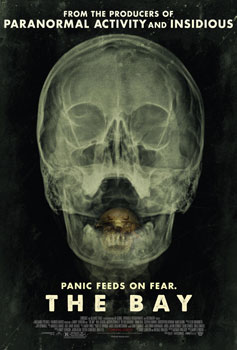Film's mutant isopods not as scary as real horrors facing the Bay
Filmmaker Barry Levinson's latest inflated tale does contain real threats. But mutant isopods aren't one of them.
Op-ed by Al Todd and Margaret Enloe
It has been a stressful few weeks for people across the Chesapeake Bay region. Ten days ago, we were in the grip of Hurricane Sandy, then last weekend, we were faced with the opening of “The Bay,” Barry Levinson's eco-horror movie set in a small Chesapeake Bay town.
Like any good horror film, “The Bay” takes elements of reality and twists them in absurd ways to capitalize on our fears. According to reviews, Levinson’s film does a good job of grabbing viewers’ attention. But Levinson has said that he wants to draw attention to the real problems facing the Chesapeake, and for this he should be applauded. It’s about time someone found a way to awaken more people to the health of our region’s waterways. It is sad, though, that a sensational and implausible story line is needed to bring about the awakening.

Image courtesy Roadside Attractions
So let’s talk about what is real and what is not in relation to the Chesapeake Bay region.
True: Every year the Bay is host to dead zones—areas of deep, oxygen-depleted water. These areas result from pollution running off the land from urban and rural areas. The size of the dead zones is influenced by water temperature and rainfall. A large dead zone spans the deepest Bay waters each summer, reducing habitat for fish, crabs and other creatures. Local algae blooms cause fish kills and can even cause crabs to crawl onto shore to breathe. Governments from New York to Virginia support a blueprint to reduce pollution flowing into local rivers and the Bay that will ultimately shrink the dead zone. Restoring the Bay will require each of us to do more.
True: The Chesapeake Bay ecosystem is one of the most studied systems in the world. It is the largest estuary in North America and third largest in the world. Since it was established by Congress in 1983, the Chesapeake Bay Program has devoted itself to understanding the complex Bay environment. All of the program’s findings are public, so there is possibly more information on the science of the Chesapeake and its tributaries than any other water body in the world. Contrary to what is portrayed in the film, we have the science, we know what is happening to the Bay and its watershed and we know what needs to be done…we all just need to do more of it!
True: Every summer, thousands of people enjoy or work the Chesapeake Bay and its rivers in a variety of ways. Luckily, aggressive, mutant isopods don’t exist, but like any other place, the Bay has its hazards: dangerous storms, periodic beach or stream closures, localized red tides, wastewater overflows and occasional increases in waterborne bacteria. These public health concerns are known and tracked by the region’s health agencies. Those who work on, live on or play on these waters can best take care of themselves by being knowledgeable and aware of their environment.
And a final truth: There is nothing more terrifying to us than the idea of something as harmless as an isopod turning against us. These tiny Bay creatures and others like them—shrimp, worms and plankton—should not be feared, but celebrated. They are the critical foundation of the Bay’s abundant resources, feeding other animals such as crabs, small fish and oysters. Without them, the Bay’s complex food web would collapse.
The Bay region is resilient, vibrant and healthy in many ways; and out of balance in others. We can celebrate that vibrancy while working to address the challenges. We agree with what Levinson said in a recent interview: “At some point, you have to say ‘we are going to deal with this, not ignore it.’ It won’t just go away. There is nothing that’s going on in the Chesapeake Bay that can't be corrected.” Maybe a good scare from “The Bay” will motivate more of the 17 million people around the region to address the challenges the Chesapeake and its many rivers face and work to finally restore this important natural and economic resource.
Al Todd is the executive director for the Alliance for the Chesapeake Bay. Margaret Enloe is also with the Alliance and is the communications director for the Chesapeake Bay Program.
Distributed by Bay Journal News Service.

Comments
I think the government has covered up many many incidents. Too many chemicals and crap placed in our water systems. There is so much unanswered questions. There r a lot of bad people out of there. Whose doing this - we r. The air, and water we need; and we r poisoning our world.
Thank you!
Your comment has been received. Before it can be published, the comment will be reviewed by our team to ensure it adheres with our rules of engagement.
Back to recent stories